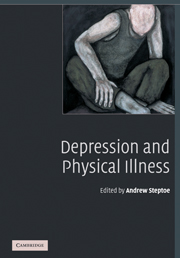Book contents
- Frontmatter
- Contents
- List of contributors
- Preface
- Part 1 Introduction to depression and its determinants
- 1 Depression in the medically ill
- 2 Psychosocial factors, depression and illness
- Part 2 Depression and specific health problems
- Part 3 Biological and behavioural processes
- Part 4 Conclusions
- Index
- References
1 - Depression in the medically ill
from Part 1 - Introduction to depression and its determinants
Published online by Cambridge University Press: 17 September 2009
- Frontmatter
- Contents
- List of contributors
- Preface
- Part 1 Introduction to depression and its determinants
- 1 Depression in the medically ill
- 2 Psychosocial factors, depression and illness
- Part 2 Depression and specific health problems
- Part 3 Biological and behavioural processes
- Part 4 Conclusions
- Index
- References
Summary
Introduction
Psychiatric disorders of all types are more common in people with physical illness compared with the general population. Depression is the most common disorder, accounting for approximately 50% of psychopathology in the medically ill, with the remainder made up of various anxiety disorders and mixed subsyndromal symptoms of anxiety and depression. The importance of depression in the medically ill lies in its adverse effect on outcome, most notably health-related quality of life, combined with the fact that it is rarely detected and treated adequately in people who have physical illness.
The prevalence of depression in medically ill populations varies greatly according to the definition of depression and the type of measure used [1–4]. Variation in the definition and measuring instrument are the main reasons for the large variation in the prevalence figures quoted in the literature [5]. A higher prevalence of depression has been reported by studies that have used a self-administered questionnaire compared with those that used standardised research interviews administered by a trained interviewer [6]. The prevalence of depression also varies according to sociodemographic characteristics of the sample and the location of the survey (out-patient, in-patient, community) [3]. Only after all of these factors have been taken into account is it possible to assess whether the prevalence of depression varies according to type of medical disorder, its chronicity or severity [2, 3].
Keywords
- Type
- Chapter
- Information
- Depression and Physical Illness , pp. 3 - 18Publisher: Cambridge University PressPrint publication year: 2006
References
- 12
- Cited by



